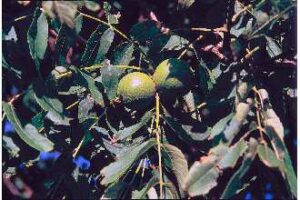By Wren Smith
 I owe my love for collecting wild edibles in part to my family’s tradition for riding down country roads in autumn looking for the tale-tell pockmarked stains of black walnut on the payment. We’d park on the side of the road, hop out of the car, carrying buckets and wearing gloves, since the outer hulls will badly stain hands. We’d gather the smashed walntuts first, since they already had their outer hull removed. Then we’d stomp on the others to loosen and remove the green outer hull. Black Walnuts, Juglans nigra, provide a prized and richly flavored nut that is especially good in oatmeal raisin cookies, brownies, and my favorite – divinity fudge!
I owe my love for collecting wild edibles in part to my family’s tradition for riding down country roads in autumn looking for the tale-tell pockmarked stains of black walnut on the payment. We’d park on the side of the road, hop out of the car, carrying buckets and wearing gloves, since the outer hulls will badly stain hands. We’d gather the smashed walntuts first, since they already had their outer hull removed. Then we’d stomp on the others to loosen and remove the green outer hull. Black Walnuts, Juglans nigra, provide a prized and richly flavored nut that is especially good in oatmeal raisin cookies, brownies, and my favorite – divinity fudge!
Aside from providing food for wildlife and humans, the value of black walnut goes beyond the dinner. Squirrels help replant the forests by burying their nuts in a practice known as scatter hoarding. Since squirrels don’t eat all of their buried nuts, some sprout and become trees. At Bernheim you will find several black walnut trees growing in the nut collection along Arboretum Way, and in many parts of the natural forest.
The wood of black walnut has been used for gun stocks, fine furniture, flooring, and more, and is sought after for its dark lustrous sheen when polished. Early Americans used the dark brown of the hulls to dye basket materials and to make a furniture stain. Some authorities say it was even used to dye hair. I wouldn’t recommend that!
A disease complex known as thousand cankers disease has been attacking black walnut in some parts of country, especially in the west. Unfortunately for the forest of the southeast, this disease has been discovered in Tennessee. If these trees disappeared from our forests the loss would be felt in ways great and small.
Want more Vanishing Acts? Click here to view the archive.
Vanishing Acts: Trees Under Threat was developed and produced by The Morton Arboretum in association with the Global Trees Campaign, a partnership between Fauna and Flora International and Botanic Gardens Conservation International.
Funding for this exhibit comes from The Morton Arboretum and the U.S. Institute for Museum and Library Services, Museums for America Grant Program.
Support locally comes from LG&E and KU. Additional support provided by Shepherdsville/Bullitt County Tourism.

